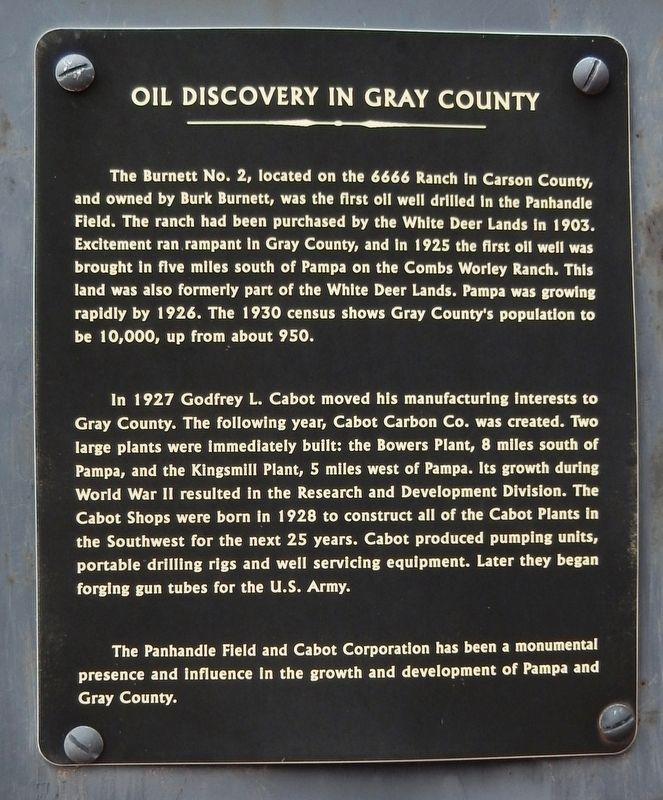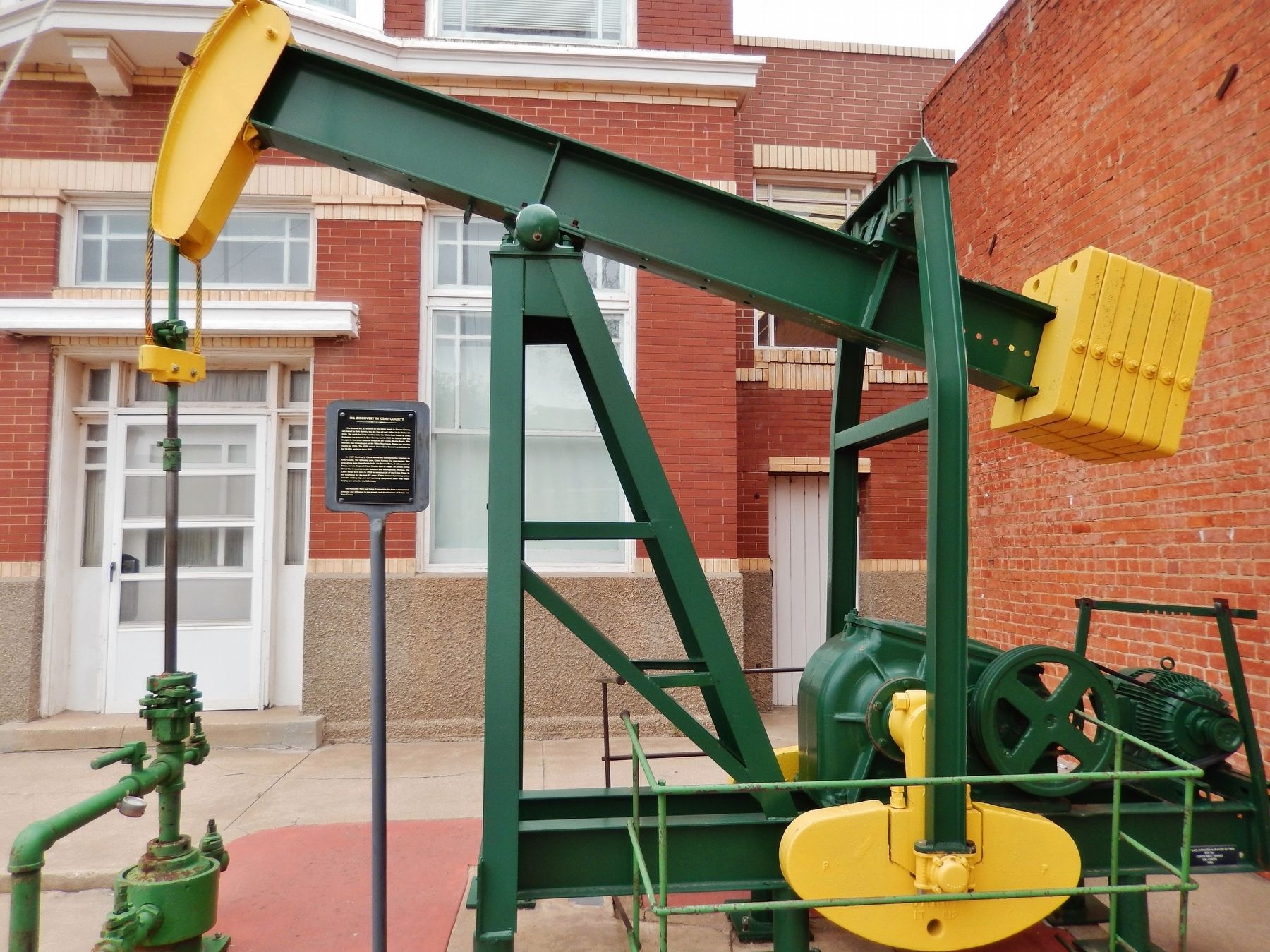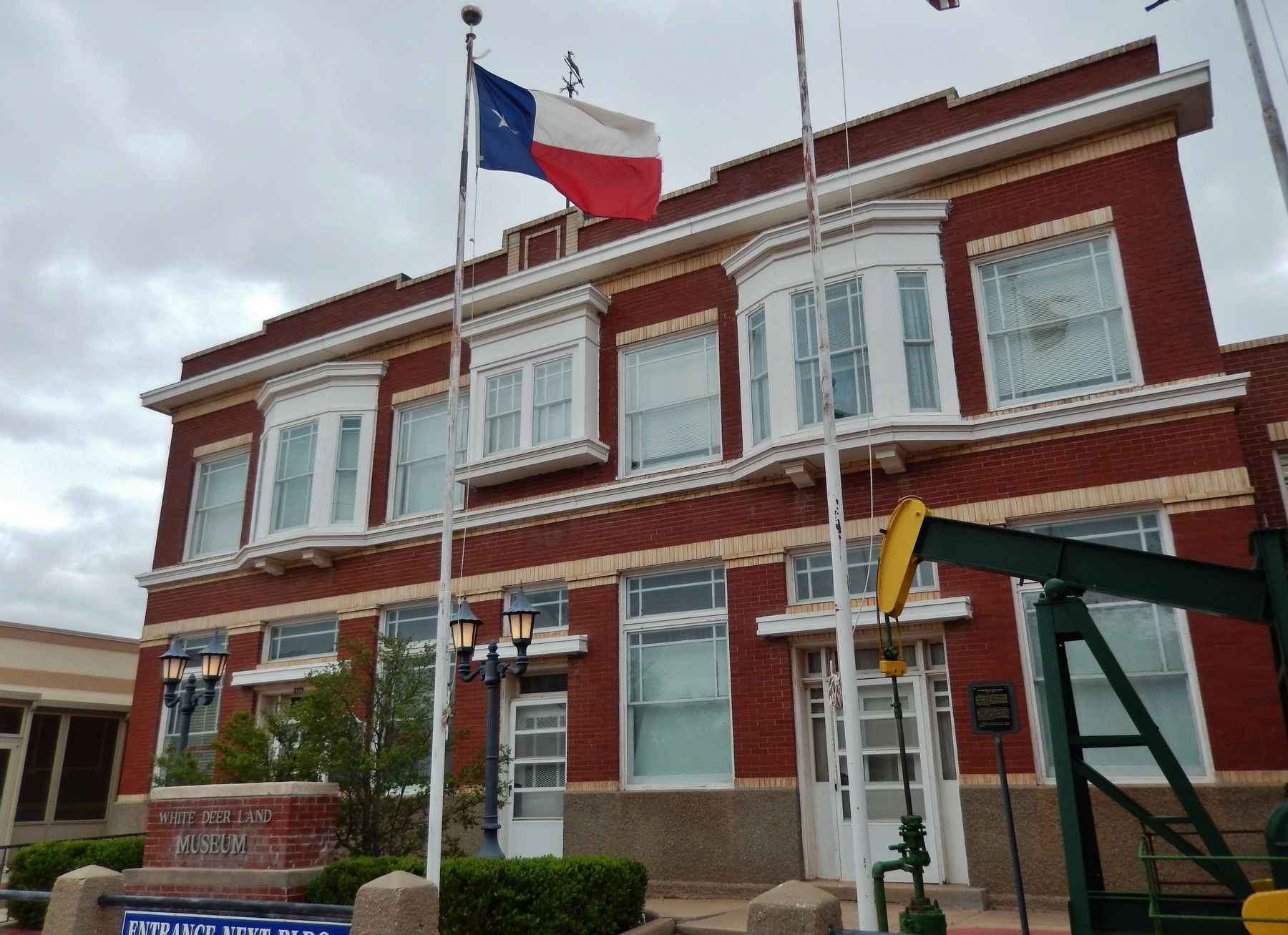Pampa in Gray County, Texas — The American South (West South Central)
Oil Discovery in Gray County
The Burnett No. 2, located on the 6666 Ranch in Carson County, and owned by Burk Burnett, was the first oil well drilled in the Panhandle Field. The ranch had been purchased by the White Deer Lands in 1903. Excitement ran rampant in Gray County, and in 1925 the first oil well was brought in five miles south of Pampa on the Combs Worley Ranch. This land was also formerly part of the White Deer Lands. Pampa was growing rapidly by 1926. The 1930 census shows Gray County's population to be 10,000, up from about 950.
In 1927 Godfrey L. Cabot moved his manufacturing interests to Gray County. The following year, Cabot Carbon Co. was created. Two large plants were immediately built: the Bowers Plant, 8 miles south of Pampa, and the Kingsmill Plant, 5 miles west of Pampa. Its growth during World War II resulted in the Research and Development Division. The Cabot Shops were born in 1928 to construct all of the Cabot Plants in the Southwest for the next 25 years. Cabot produced pumping units, portable drilling rigs and well servicing equipment. Later they began forging gun tubes for the U.S. Army.
The Panhandle Field and Cabot Corporation has been a monumental presence and influence in the growth and development of Pampa and Gray County.
Topics. This historical marker is listed in these topic lists: Industry & Commerce • Man-Made Features. A significant historical year for this entry is 1925.
Location. 35° 32.11′ N, 100° 57.675′ W. Marker is in Pampa, Texas, in Gray County. Marker is on South Cuyler Street south of West Foster Avenue, on the right when traveling south. Marker is located beside pumpjack exhibit, near main entrance to the White Deer Land Museum. Touch for map. Marker is at or near this postal address: 116 South Cuyler Street, Pampa TX 79065, United States of America. Touch for directions.
Other nearby markers. At least 8 other markers are within walking distance of this marker. White Deer Land Building (a few steps from this marker); Vittorio Emanuel von Brunow, M. D. (within shouting distance of this marker); Quanah Parker Trail (within shouting distance of this marker); First National Bank in Pampa (about 300 feet away, measured in a direct line); Pioneer Cottage (about 300 feet away); 1934 Pampa Post Office Building (about 400 feet away); Pampa (about 500 feet away); Pampa City Hall (about 600 feet away). Touch for a list and map of all markers in Pampa.
Also see . . .
1. Gray County, Texas. Oil and gas exploration began in the county during the early 1920s. A major discovery well five miles south of Pampa, the H. F. Wilcox Oil and Gas Company's Worley-Reynolds well, drilled in 1926, led to more developments around Lefors. Between
1925 and 1928 increasing amounts of oil came out of the county's three oilfields (the Lefors, Bowers, and south Pampa fields). Production mushroomed in 1929, and the county became and remained a substantial oil producer. (Submitted on December 15, 2017, by Cosmos Mariner of Cape Canaveral, Florida.)
2. Oil Boom Days - 1925. 1925 marked one of Gray County's most important years. When oil was discovered that year, citizens of Gray County had no idea of the vast changes ahead. Pampa soon became home for many oil field hands, promoters, prospectors, and speculators. The third major economic resource had been added - the petroleum industry. (Submitted on December 15, 2017, by Cosmos Mariner of Cape Canaveral, Florida.)
3. Oil and Gas Industry. Full development of discoveries in Gray County produced production of 32,274,822 barrels in 1930. During 1926, seven oil companies constructed pipelines and storage facilities in the area, some connecting to systems that reached the Gulf Coast and Oklahoma. (Submitted on December 15, 2017, by Cosmos Mariner of Cape Canaveral, Florida.)
4. White Deer Land Museum. (Submitted on December 16, 2017.)
Credits. This page was last revised on December 16, 2017. It was originally submitted on December 15, 2017, by Cosmos Mariner of Cape Canaveral, Florida. This page has been viewed 447 times since then and 22 times this year. Photos: 1, 2, 3. submitted on December 15, 2017, by Cosmos Mariner of Cape Canaveral, Florida. • Bernard Fisher was the editor who published this page.


